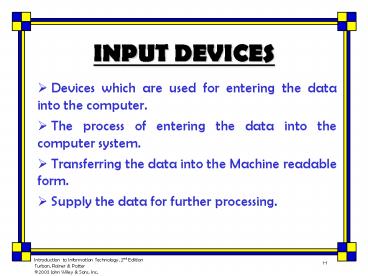INPUT DEVICES - PowerPoint PPT Presentation
1 / 19
Title: INPUT DEVICES
1
INPUT DEVICES
- Devices which are used for entering the data
into the
computer. - The process of entering the data into the
computer system. - Transferring the data into the Machine readable
form. - Supply the data for further processing.
2
Data Entry Concepts
- Entering of the data into the computer in timely
manner, at reasonable cost and with minimum of
errors. - 2 basic ways in which data are entered
- Transcriptive Data Entry
- Source Data Entry
- In Transcriptive, the data is entered on
documents. For example, handwritten. - In Source Data Entry, the data are prepared at
source in machine-readable form.
3
ON-LINE/OFF-LINE
- Device used to enter the data can be either
on-line or off-line. - On-line refers to devices that are directly
connected to CPU. - Off-line refers to devices that are not directly
connected.
4
INPUT ACCURACY
- Errors may occur during entering the data.
- 2 various methods used to eliminate the errors
- Verification
- Validation
- Verification is the checking of data against a
known source. - Validation is the checking of data that deviate
from this range.
5
INPUT DEVICES
- Input is the process of entering and translating
incoming data into Machine-readable form. - Hardware is the physical component of computer
system. - Any hardware that is attached to main unit of
computer is Peripheral Device. - So input device is peripheral device through
which data is entered. - Various Input Devices are.
6
1. KEYBOARD
- Most preferred and common input device.
- Traditional QWERTY keyboard.
- Feature of the Keyboard
- Standard Typewriter Keys
- Function Keys
- Special Purpose keys
- Cursor-movement keys
- Numeric keys
7
2. MOUSE
- Developed by Doug Engelbart in 1960.
- It is used instead of Enter (Return) key on
keyboard. - Operates either electromechanically or
optically. - electromechanical mouse has sphere on its under
side. - Optical mouse travels over special table of grid
lines.
8
3. JOYSTICK
- Input device that enables the user to control
the position of the cursor with the help of
lever. - It sends the digital signals to control the
cursor movements. - Used to play computer games.
- It provides the user eight direction movements.
9
4. TRACKBALL
- Input device which is variation in the mouse.
- It is like an upside down mouse.
- It has ball on the top and the user moves the
ball directly with the hands. - Firstly used in the Laptops.
- Rotation of the sphere translates the direction
and speed into digital signals used to control
the cursor.
10
5. TOUCHPAD
- Input device used in the modern laptops.
- User can move the cursor around the screen by
moving the finger on the pad. - For clicking there are two buttons and also the
user can tap the pad for clicking an icon.
11
6. TRACKPOINT
- Input button which is protruded in between the
keys of the keyboard. - Works like mouse.
- Rotate the cursor around the screen.
12
7. TOUCH SCREEN
- It registers the input when a finger or object
comes in contact with the screen. - It employs the technique of infrared beams and
Ultrasonic Acoustic Waves. - Infrared beams crisscross the surface of the
screen and when beam is broken the location is
recorded. - Ultrasonic waves pass over the surface of the
screen and when wave signal is interrupted the
location is recorded.
13
8. LIGHT PEN
- Hand held pen shaped input device connected by
cable to computer and is used special software to
detect light. - It looks like an ordinary pen but its tip is
light sensitive detector. - It does not emit light rather it reacts to light
through photosensitive detector. - Frequently used by the graphic designers and
drafting engineers.
14
9. Digitizer
- Input device similar to light pen.
- Difference is it uses separate pad called
graphic tablet on which the pointing device is
moved.
15
10. SCANNER
- Also called Optical Reader.
- works like photocopier machine.
- It digitizes the information into computer.
- It take an electronic image of the text or
graphs and breaks each image into thousands of
light dark dots. - Passes strong light on the text.
16
11. MICR
- Magnetic-ink Character Recognition.
- The interpretation by computer of line of
characters written in special magnetic ink. - Mainly used in the banks for the processing of
cheques.
17
12. OMR
- Optical-Mark Recognition.
- Simplest form of optical recognition.
- Employs mark sensing.
- High intensity of light that is directed in the
form of beam at the sheets of the paper being fed
through it. - To scan and translate the locations of pen or
pencil marks into computer.
18
13. BCR (OBR)
- Bar Coded Recognition (Optical Bar Recognition).
- Optical bar reader scans, recognizes and
interprets a patterns of lines that form a bar
code. - Bar code also called product codes.
- By passing some laser beams.
- UPC (Universal Product Code)
19
14. OCR
- Optical Character Recognition.
- Device that reads alphanumeric characters of
both handwritten or typed text. - These characters are interpreted by passing some
strong light. - The characters must be recognized by
standardized fonts called Optical fonts.































